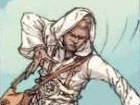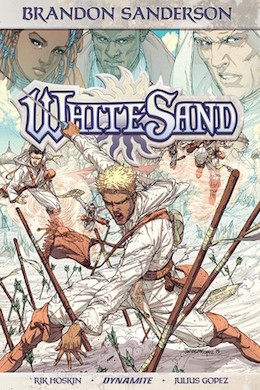Though it was one of his earliest projects, Brandon Sanderson just couldn’t seem to find the right way to bring White Sand to the world. Going through several drafts, it ended up sitting on his desk looking for the proper way to emerge, despite it being one of his favorite projects to work on. And now with his other series and obligations to juggle, Sanderson feared that he’d never get a chance to put out White Sand.
But, as he states in his opening essay, when approached by comic book company Dynamite for consideration for a project, Sanderson looked back at his desk and had an idea. White Sand the graphic novel was born, a new Sanderson Cosmere story in an entirely new medium for him and for the first time, manned by a whole new creative team. And while it’s a departure from his normal medium, the same Sanderson charm, style, and magic is present, despite some awkward moments.
Living on Dayside, the half of the tidally-locked planet Taldain under perpetual sunlight, Kenton is the son of a hard-bitten Sand Master. And while he should have inherited his father’s masterful prowess when it comes to controlling and using the magical sand in their desert home, Kenton can barely summon the energy necessary for one ribbon of sand, let alone dozens. So as the graphic novel begins, Kenton is insistent on running the Master’s Path, a trial to determine if he too can become a Sand Master like his father, or if he’ll fail again, and be given the lowest rank. Yet, in the middle of all this drama, a group of fanatical warriors arrive onto the scene and manages to murder every last Sand Master except for Kenton, who is saved in a last burst of strange, magical energy by his father. When he awakens, alone in the desert with no clue as to what happened, no survivors, and with barely a ribbon of sand to his name, it’s up to Kenton to carry on the legacy of his father and his people. And when a group of Darksiders, people living on the other side of the planet where it is always night, find Kenton, he finds he may have a chance to find out what happened, avenge the lost, and become a Sand Master in truth.
It’s odd reviewing this, because this is only the first piece of the puzzle. As is the case with many Sanderson books, the prose version of White Sand adapted for the graphic novel was rather robust. So rather than write and illustrate a four hundred page graphic novel, Dynamite is releasing three volumes. So while I’d love to judge the whole story, I can’t; I only have the opening salvo to review, so that has to be kept in mind: we’re not getting the full story yet. But what we are getting is an introduction to a brand new and magical world, brand new characters who have learned to thrive in it, and the beginnings of lore, conspiracies, and action that will carry us through the next two volumes. And while we do get those beginnings, as well as some very brief glimpses into the Cosmere of this planet and its characters, volume one is laser-focused on introductions.
In many ways, this story plays to Sanderson’s strengths, but with some interesting snarls: Kenton is an outsider, shunned for his lack of ability and seen more as a weakness or liability than someone who can help or lead, even despite all the training and pain he’s gone through to gain what little respect he has. But his lack of power has given him creativity, which time and again proves a boon in his mission. Khrissalla is a Duchess from Darkside, trying to forge onward in her deceased lover’s mission to find out if the ancient Sand Masters of Dayside are real. But rather than a warrior or a diplomat, she’s a scientist, searching for proof of the magic that on her side of the planet is only thought of as a myth. There’s the visually kinetic magic system of Sand Mastery, whereupon Sand Masters can draw upon the energy in the white sand itself, charged by the ever-present sun above, and use it to do all sorts of cool things (throw as a weapon, crafting shields, levitate), except it comes with a dire result if you misuse it or don’t respect it. Already this first volume confirms a massive Cosmere theory, and nudges forward our understanding of other players in the history of the Cosmere itself. There are secondary characters with wit and intelligence, and there are also several different cultures, political figures, religions, and social systems that we only get glimpses of, but seem interesting and full of potential.
But despite the potential in this first volume, there are a few things holding it back. And to clarify, these are issues that may resolve in the next two volumes, but without that context, this is what’s left to show: there are some questionable story moments that made me feel a little odd. The biggest one being that right now we have a group of so-called savages with darker skin than the protagonist, murdering blatantly for religious reasoning, and right now, there is very little context given to these characters beyond the above. And I firmly believe Sanderson is a smart author who has thought through this, and that these warriors could very well be given the depth and context necessary to remove them from a long line of stereotypes and uncomfortable representation in the coming volumes. But at the moment, it sits how it sits and it threw me off, because Sanderson is usually a much more nuanced writer. Though again, remember, we are not getting all the puzzle pieces; we only have what’s given to us, so I’m reserving judgement until I get to see how these characters and their culture and religion develop. There are plenty of other characters outside of our protagonist’s culture represented well, and with actual depth, but this was one moment I was made uncomfortable with the story choice.

Likewise, another thing holding this graphic novel back, is the pacing. And this is coming from someone very familiar with Sanderson’s writing style; this note is directly because this is an adaptation rather than an original work. In any Sanderson novel, you’re going to have tight, lean pacing, with plenty of character backstory and point of view mixed in, making for a brisk, but substantial story that zips as much as it takes its time. Here however, you don’t get those interior character points of views as often, which is mostly fine as the art is now doing the bulk of subtext and nuance. However, in moments of transition between characters, or in moments leading up to big events or attacks, all build is lost. Scenes just end without any sort of denouement on what just happened. Characters are introduced suddenly, in media res, and while this isn’t normally an issue in a Sanderson story, here there is a lack of point of view that would let us engage with this character and ease us into this new setting. It is no fault of the writer and artist, or even Sanderson himself, it’s just another potential pitfall of the adaptation into the new media form, and unfortunately, it is a more glaring issue than I’d have thought. Again, this is an issue that could be smoothed over with the next two volumes, but at the moment, I found it jarring and it definitely threw me off more than once.
Before I wrap this up, a tip of the hat to the creative team, Rik Hoskin who wrote White Sand, and Julius Gopez who illustrated it, with colors by Ross A. Campbell, and lettering from Marshall Dillon. These creators had a herculean task: take a novel by a writer who is known for his detail and length, and condense it into a lean graphic novel. Never mind that it will be split into three volumes; Hoskin and Gopez worked with Sanderson, and altogether, they’ve made a successful adaptation. Hoskin’s writing preserves what makes Sanderson’s stories so accessible, charming, and intriguing. Gopez’s artwork meanwhile channels the otherworldly beauty of this bright, alien ecosystem, complete with giant monsters, sand magic, and expressive characters. Sometimes the art can be more granular than precise, though I find that works with the world we’re in. I look forward to seeing how this creative team tackles the rest of White Sand, and commend them on an opening act well done.
Overall, White Sand is a success, and a definite win for Team Sanderson. It is a faithful, lean adaptation, that introduces Sanderson fans to a new Cosmere world with fascinating magic, nuanced characters, and bubbling conflicts that are sure to boil over in the next two volumes. Despite some narrative hiccups, and some storytelling choices that concern me until I can get more context, White Sand was a fun read from end to end, and I look forward to seeing what comes of Kenton, Khriss, and every other character under the White Sand sun.
White Sand Volume 1 is available now from Dynamite Entertainment.
Check out a preview of the graphic novel.
Martin Cahill is a contributor for Tor.com, Book Riot, and Strange Horizons. You can find him on Twitter @McflyCahill90. Tweet him about delicious east coast IPAs, ideas on who Rey’s parents are, and your worries about the DC Movie Universe.










